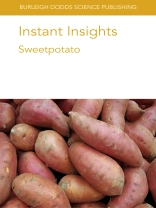This specially formulated collection features 3 reviews of current topics and key research in sweetpotato.
The first chapter examines the origin and dispersal of sweetpotato, considers in vitro germplasm storage in sweetpotato genebanks, and looks at the importance of managing sweetpotato crop wild relatives (CWR). The chapter also considers the specific issues associated with sweetpotato germplasm, as well as the application of next-generation sequencing to sweetpotato and its CWR.
The second chapter reviews the development and application of genetic transformation and trait improvement to sweetpotato, including the development of sweetpotato plants which are resistant to disease and abiotic stress, and sweetpotatoes with improved starch quality and higher anthocyanin content.
The final chapter examines the nutritional contribution made by OFSP (orange-fleshed sweetpotato) in poor rural communities in Malawi, Ghana, Nigeria and Burkina Faso; sustainable breeding and seed systems; and effective commercialisation and marketing to benefit the communities concerned. This chapter includes detailed case studies from Ghana and Malawi.
Jadual kandungan
Chapter 1 – Sweetpotato genetic resources: today and tomorrow: Robert L. Jarret, USDA-ARS, USA; Noelle L. Anglin and David Ellis, International Potato Center, Peru; Arthur Villordon, Sweet Potato Research Station, USA; Phillip Wadl and Michael Jackson, USDA-ARS, USA; and Genoveva Rossel, International Potato Center, Peru; 1 Introduction 2 Origin and dispersal 3 Archaeological data 4 General botany 5 Sweetpotato genebanks/germplasm collections 6 In vitro germplasm storage 7 Quality control 8 Management of sweetpotato CWR 9 Plant quarantine/phytosanitary issues/IPR 10 International treaties 11 Sweetpotato germplasm 12 NGS applications to sweetpotato and its CWR 13 Conclusion and future trends 14 Acknowledgement 15 Where to look for further information 16 References
Chapter 2 – Developing new sweet potato varieties with improved performance: Peng Zhang, Weijuan Fan, Hongxia Wang, Yinliang Wu and Wenzhi Zhou, Institute of Plant Physiology and Ecology, Chinese Academy of Sciences, China; and Jun Yang, Shanghai Chenshan Plant Science Research Center, Shanghai Chenshan Botanical Garden, China; 1 Introduction 2 Genetic transformation of sweet potato from model cultivars to farmer-preferred cultivars 3 Production of disease-resistant sweet potato 4 Production of sweet potato resistant to abiotic stresses 5 Starch modification for industrial applications 6 Increased understanding of storage root development for better yield 7 Production of purple sweet potato with increased anthocyanin content 8 Conclusion and perspectives 9 Where to look for further information 10 Acknowledgements 11 References
Chapter 3 – Improving the breeding, cultivation and use of sweetpotato in Africa: Putri Ernawati Abidin and Edward Carey, International Potato Center (CIP), Ghana; 1 Introduction 2 Programmes for improving sweetpotato as a crop 3 Developments in breeding and seed dissemination 4 Improvements in cultivation and post-harvest handling 5 Nutritional quality and its improvement 6 Crop diversification for new uses 7 Case studies: Malawi 8 Case studies: Ghana 9 Conclusion and future trends 10 Where to look for further information 11 Acknowledgements 12 References
Mengenai Pengarang
Dr Erna Abidin is CIP Seed System Scientist and Project Manager for Jumpstarting Orange Fleshed Sweetpotato in West Africa through Diversified Markets. She has over 20 years sweetpotato experience and is based in Tamale, Ghana.












